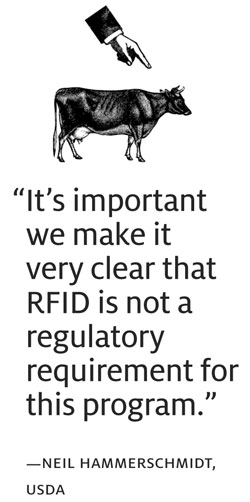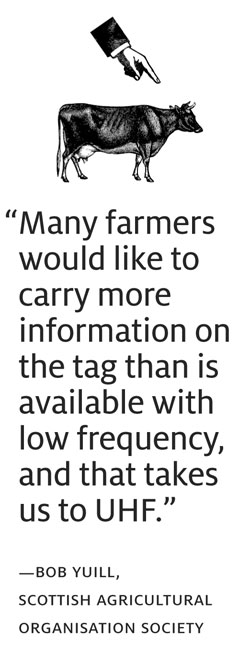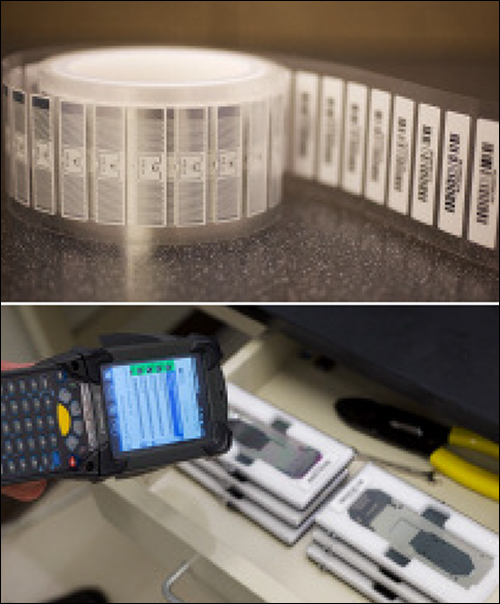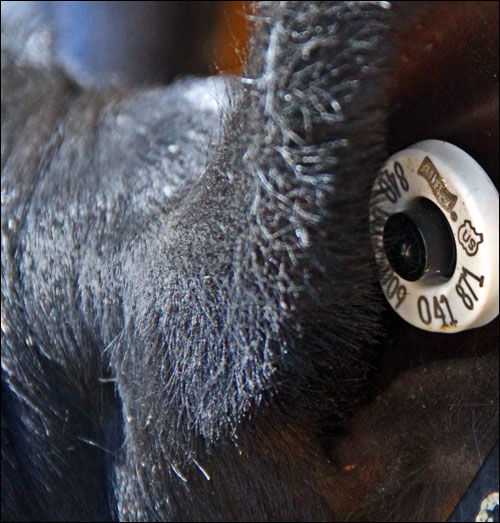Oct 28, 2016The quality of any health-care laboratory—whether it's servicing the biomedical, clinical trial and research, diagnostic or pharmaceutical community—depends on its ability to provide accurate, precise and timely results. In recent years, some labs have begun using RFID to automate manual processes to track human specimens and other samples, preventing loss and misidentification, assuring chain of custody, enabling quick retrieval when needed and facilitating compliance with government regulations.
In 2011, for example, the Mayo Clinic's department of laboratory medicine and pathology worked with software provider ODIN (now Quake Global) to develop EasySpecimen, a passive RFID system to track patient tissue samples. In 2013, the Legacy Health Good Samaritan Medical Center, in Portland, Ore., collaborated with Cerner to deploy an RFID solution to track patient tissue specimens from the point of collection in the endoscopy department to receipt at the pathology lab. Prior to using RFID, endoscopy nurses had to manually create and double-label specimen containers, and pathology lab workers had to verify the containers against paperwork before entering their receipts into the Cerner Laboratory Information System (LIS). The RFID solution integrates Quake Global's pad readers, ceiling readers and Tag Acquisition Processor (TAP) server with the Cerner LIS.
"Now, nurses provide specimen source information to the hospital's electronic medical records system, submit the order to the EMR and print an RFID label," says Dani Sensenig, pathology supervisor for Legacy Laboratory Services. Zebra Technologies' tags and printers are used in the process. It's best practice to print the label at the point of blood collection or specimen removal, says Chris Sullivan, Zebra's global health-care practice leader. "If you have the label applied instantaneously to the blood collection or specimen, you significantly reduce the risk of errors versus doing that as a separate work stream."
Then, nurses place the specimen container on an RFID pad in the endoscopy suite, and the reader sends a signal to the LIS that the specimen is ready for pickup. Antennas in the hallway outside the suite and outside the pathology department track the movement of the sample, which is read on another RFID pad when it arrives at the lab. "In health care, this workflow is a game changer," says Sam Bhatia, Cerner's director of laboratory automation.
"It's absolutely beneficial to the lab because specimens are the bread and butter of what we do," Sensenig says. "The quality of specimen identification, the labeling of containers and tracking transportation is all part of the process," says Andrea Stacy, Legacy Health's manager of system pathology and cytology labs. "If pathology expects to receive a specimen that doesn't show up, we can actually track if it left the endoscopy department or if it came into our lab." Today, Stacy notes, the pathology lab RFID-tracks between 1,200 and 1,500 endoscopy specimens annually, with a 100 percent read rate.
The Cerner RFID Anatomical Pathology tracking solution is generating a lot of interest at Good Samaritan Medical Center. "Other departments that produce pathology specimens have reached out to learn more about the work," Stacy says. "And there's potential to leverage RFID to track the samples through the lab's internal processes," adds Bryan Desimone, a Legacy Health senior system analyst who supports the pathology lab. "We're starting small and hoping to grow."
RFID providers have addressed many hardware and software issues, so the technology can now be used in labs to monitor samples. They also have developed inventory-management solutions to help labs better manage their equipment and supplies. Targeted solutions, and innovations on the horizon, promise to make RFID a standard tool in labs. Still, the initial cost of implementing an RFID solution remains a challenge to adoption.
Targeted Solutions
RFID providers are helping labs find the tags and antennas that work best for tracking specimens in what are often cramped environments. Very small high-frequency RFID tags work well for item-level tracking of liquid-filled containers, and small ultrahigh-frequency tags can be paired with vials that contain mostly solid substances, such as human tissue, says Frank Gao, CEO at GAO RFID, which offers the Specimen Tracking System—a complete hardware and software solution for monitoring samples from collection through delivery to the lab in real time and throughout the diagnostic and testing processes.

The Specimen Tracking System can be deployed alone or as part of the company's Smart Labs Pro cloud solution, designed to "strengthen communications between workers at one lab organization with multiple locations or across multiple lab companies, and to use this kind of information to help their daily work become more efficient," Gao says. "Each individual user of the system can log in from anywhere and, in the same timeframe, share the information of specimen type and location." Authorized personnel can access the company's online database to monitor items throughout the diagnostic and testing process—and track samples that are transferred to a central lab facility. The solution can incorporate GPS coordinate information during scans, and cool transport boxes can be monitored to provide a temperature history.
To read samples that are being processed at the same time in close proximity, low-profile near-field antennas can be mounted under lab workstation countertops, says Brett Wilkerson, RFID business development director for systems integrator MSM Solutions. "You have to be able to cut down read ranges and read zones," he says, "so you show things where they actually are, and not 20 feet away, with the right power levels and settings." To RFID-enable a lab, MSM uses the hardware best suited for each environment, including Impinj Speedway Revolution readers, Zebra fixed and mobile readers and Times-7 antennas, and its own PortralTrack software for monitoring and managing the hardware and providing users with real-time views of where samples are flowing throughout the facility.
MSM recently implemented an RFID solution for forensic toxicology and health-care sciences lab Aegis Sciences, to monitor the status of the blood and urine samples as they move from one instrument to another or from one section of the lab to another. "A side benefit of RFID, especially with blood and urine labs, is they can gain a lot of metrics by knowing how long things sit at a particular station because they're always reading the sample," Wilkerson says. They can get visibility from that data into things such as which stations are not in use and which samples are waiting to be processed, he adds, to improve workflows and productivity, thereby gaining a competitive edge.
Cold Storage
Labs routinely use biologics, reagents and other products that must be stored at cool temperatures. Labs have several choices when it comes to RFID-tracking samples that need to be refrigerated. And now, RFID can address what providers say has been the holy grail: the ability to track lab products inside freezers.
One solution is Ruro's FreezerPro, designed for tracking the collection and then management of frozen samples in scientific or pharmaceutical labs. Its cryosafe RFID labels are designed to survive 10 or more years in liquid nitrogen freezer environments, says COO Tom Dolan. Labs can use FreezerPro to check samples into and out of freezers by briefly holding boxes of individually RFID-tagged samples over an RFID antenna. Its software, which is available as a cloud-hosted service, stores all samples' information, including date and time specimens were checked in or out.
Labs can also use FreezerPro's software to create virtual freezers that reproduce the exact configuration of the real freezers, including doors, racks and samples' storage locations, to quickly locate items. But if someone puts a sample on the wrong shelf or in the wrong rack or the wrong freezer, the software would not be able to detect it, because the tags aren't read in the freezer.

SpaceCode and Terso Solutions offer RFID-enabled refrigerators and freezers that monitor access and who took out what items and when. They can also monitor temperature, manage product inventory in real time and streamline the reordering process. And these smart solutions can monitor samples and specimens in cold storage in real time.
With SpaceCode's cold storage devices, for example, once tagged samples and specimens are entered into its software system, they can be stored in a fridge or freezer in any position, says CEO Pavlo Protopapa. A lab technician can use the device's built-in screen to view each item's location and more easily find needed items, including those that may inadvertently have been moved to the wrong storage device. The device's interior LED lighting indicates the storage slot where the sample is being held. The company's SmartBoard, an RFID work-surface reader, can be used to track samples and specimens as they are passed between individuals and processes, to reduce manual errors.
On another front, BioTillion has a grant from the National Institutes of Health for a project to create a smart freezer that can track sample boxes even when the freezer door is closed, says CEO Hanan Davidowitz. In the next few months, the company plans to launch a ColdSight beta test site at a biobank.
All the system's movable parts—the boxes and the racks that hold the boxes are powered and accessed wirelessly, Davidowitz says, and all the system's components must operate from room temperature down to -80 degrees Celsius (-112 degrees Fahrenheit). "You have to get the electronics to work in ultralow temperatures and to be rock solid," he says.
ColdSight can leverage BioTillion's BoxMapper technology, which can map the contents of a standard freezer box of RFID-tagged samples in vials within seconds; the vials are associated with the box before they are stored in the freezer. As with other freezer solutions, the RFID-tagged boxes can be taken out of cold storage and read immediately. "If samples are optically bar-coded, the tubes need to be manually defrosted," Davidowitz says. "That takes additional time during which the samples' temperatures rise—this is to be avoided at all costs."
The ability to quickly identify required vials also addresses another common problem, Davidowitz says: In most labs, technicians usually have some idea which samples are in which freezers, but to get to those samples when needed, they often start pulling out other boxes and items. That can cause temperature fluctuations in the products and in the freezer overall. Temperature fluctuations can also occur when inventory is conducted manually. "A freezer warms up every minute you open the freezer door," he says. "It can take a couple of hours for it to cool down if you open the door even for two minutes."

ColdSight also features temperature sensors, to monitor a freezer's performance. "No one had this information before, so we don't even know what people are going do with it," Davidowitz says. But, for example, he says labs could ensure that samples particularly sensitive to temperature variances within freezers are placed in optimal locations.
BioTillion will offer ColdSight in its first implementation as an option users can order with new Stirling Ultracold lab freezers or as retrofits to existing Stirling freezers. BioTillion designed the system to be flexible in respect to freezer organization, Davidowitz says. One freezer model, for example, might store many small sample boxes and another might store fewer but larger boxes, in racks that vary significantly in size. The company has built enough flexibility into the system that it will be able to work with other manufacturers' freezers, either as built-in or bolt-on options, the CEO notes.
Cold storage also plays a role in SmartLab, a EuroCPS-funded project that aims to reduce bottlenecks during sample processing in clinical studies. A biolab, for example, could house a few thousand test tubes, so searching for individual test tubes from storage racks is time consuming and error prone. The project was developed by molecular diagnostics product developer Neumann, which chose the Budapest University of Technology and Economics' (BME) department of electron devices as its design partner. The effort targets tracking cervical samples for lab tests and processes related to the field of infectious diseases, but can be employed for any specimen tracking requirements.
The project includes a cloud-based data-and-quality management system and RFID tags that can withstand temperatures of 0 degrees Celsius to -20 degrees Celsius (+32 degrees Fahrenheit to -4 degrees Fahrenheit), so the tags are readable as soon as they are removed from storage freezers. The tubes are tracked continuously for quality assurance—they are transported in intelligent holder racks equipped with temperature or other environmental sensors, and the racks are placed in RFID-enabled docking stations at lab technicians' workstations.
When technicians need to retrieve certain types of samples—say, specimens taken from women under age 25 infected by the human papillomavirus—they can remove racks from the freezer and query the cloud database. "There is a light indicator in each sample for the rack, which calls up the samples in question," says Ferenc Ender, an assistant professor at BME who is managing the project on the design side. "So that's a help for an operator to select some specific samples from over a few thousand samples and, therefore, speed up the sample process time."
Slowly but steadily, RFID-tracking specimens from collection into labs and across workstations is gaining a foothold. GAO RFID, for instance, says 10 customers are using its solution, and the company sees fast growth in the market thanks to the visibility, traceability and loss prevention it offers. Of course, CEO Gao says, there is the typically initial resistance due to RFID's costs. But, he says, "they become happy once they see the ROI."

FreezerPro's Dolan believes the value of RFID in inventorying high-sensitivity or even dangerous cold samples—vials of anthrax in government labs, for instance—or in dealing with ongoing manual check-in and check-out of such samples will drive adoption. Instead of having to take boxes out of freezers and visually confirm the presence of individual vials, he says, end users increasingly appreciate the ability to use RFID to put a box on an antenna "and read everything inside it without opening it, no line of sight required. That's where a lot of our customers get value."
SpaceCode's Protopapa also predicts wide-scale adoption of comprehensive RFID-enabled cold storage solutions: "It no longer makes sense to have no security and manual inventory management and no business intelligence."
RFID Is Instrumental in Managing Lab Assets
Laboratories depend on a variety of instruments and devices to analyze, measure and process chemical compounds, drugs, tissue samples, specimens and so on. "Lab environments can be very unstructured," says Scott Thull, Agilent Technologies' senior product manager for life sciences. "They have small and large devices, things that go into freezers or hot environments, things that move around and things that are stored in drawers—and there's no traceability," he says. "So they can't answer questions about what they have, whether they are using it and where it is."
Answers to those questions could help labs control inventory and labor costs and adhere to audit guidelines. Pharmaceutical labs, for example, are often under pressure to begin new drug trial projects fast, Thull says, so they buy new instruments when they have the appropriate device sitting idle elsewhere in the same building. They also have to ensure quality control of instruments that are used in testing production drug samples, he explains. In many cases, instruments have multiple parts, all of which must be compliant with regulatory requirements. This means labs have to make sure they don't replace broken parts with working but noncompliant ones, which could lead to a drug batch recall.
To help labs track their assets efficiently and cost-effectively, Agilent developed the RFID-based CrossLab Inventory Management Service. The solution involves a four-phase process that begins with getting a list of the lab's assets and then matching that to the Agilent database of more than 30,000 devices—it's the equivalent of retail UPC codes, Thull says. "We map their list to our file, which we know has consistent names, manufacturers and equipment model numbers, so we don't have the same instrument called something different in three different locations on the customer site," he says. "We clean up their lists."

Next, Agilent sorts through the "the jungle" of instruments and devices the client has to find out what's really there, Thull says. Then the vendor chooses the best passive Omni-ID RFID tag for identifying each item, such as stainless steel and plastic assets and those that must withstand repeated exposure to chemical washings.
Finally, each tag's unique identification number is associated with the item in the cleaned-up inventory database. The Agilent database is integrated with Omni-ID's ProView software, which allows each customer site or location to have its own view of its data, and each corporate customer to have an aggregated view of all of its locations, inventory and maintenance records.
Labs that use the Agilent solution can conduct inventory with an RFID handheld reader. CrossLab is an all-inclusive service, Thull explains, so Agilent will provide field teams to conduct inventory, freeing customers to work on other important lab operation tasks. "With RFID, we can do this quickly, scanning the lab and knowing we're in pretty good shape," Thull says. "The real win is the ability to do more frequent inventories and do them accurately."

